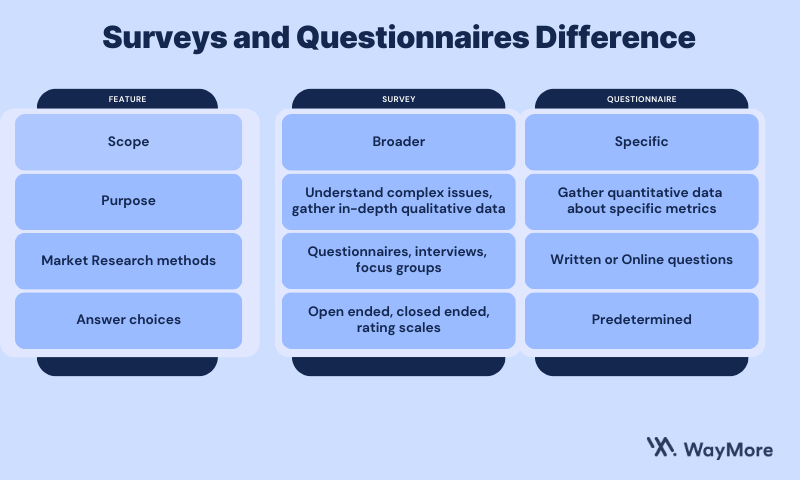Quick Links
It’s important for businesses to know what customers like and think in today’s data-focused world. Conducting market research surveys and questionnaires are popular data collection methods used to gather valuable insights.
But because people often use these terms synonymously, they can cause confusion. This blog post will explain the key differences between surveys and questionnaires, helping you choose the right tool for your research needs.
Benefits of Surveys and Questionnaires
Both questionnaires and surveys in research offer significant advantages for businesses:
- Cost-effective: Compared to other research methods, surveys and questionnaires are relatively inexpensive to conduct.
- Scalability: They allow you to reach a large number of people efficiently, making them ideal for gathering data from a broad sample.
- Data analysis: Standardized formats in questionnaires make data collection and analysis easier and faster.
- Actionable insights: The data gathered through surveys and questionnaires can be used to make informed decisions about products, services, marketing strategies, and customer satisfaction.
Choosing Between Surveys and Questionnaires
The best choice for your research depends on your specific goals and the type of information you need to collect. Here’s a quick guide:
- Use surveys when: You need to understand complex issues, explore various perspectives, or gather in-depth qualitative data. Surveys are ideal for situations where open-ended survey questions and detailed responses are necessary.
- Use questionnaires when: you want to gather numerical data about specific metrics or demographics for your market research. Questionnaires are good for getting fast and standard answers from many people. They are commonly used for online surveys.
Which Research Methods Do Surveys and Questionnaires Use?
Surveys and questionnaires can utilize a variety of research methods, but the key difference lies in how they structure those methods.
Surveys
Due to their broader scope, surveys can incorporate a wider range of research methods. This toolbox approach allows researchers to gather a more holistic understanding of a topic. Here are some common methods employed in surveys:
- Questionnaires: As mentioned previously, questionnaires are a staple within surveys. They provide a standardized way to collect quantitative data through predetermined answer choices.
- Interviews: Surveys can leverage interviews, which involve a trained interviewer asking open-ended questions to a smaller group of respondents. Interviews allow for in-depth exploration of a topic and can reveal nuances not captured by closed-ended questions.
- Focus Groups: Surveys can also utilize focus groups, which bring together a small group of people to discuss a particular topic. Focus groups can generate valuable qualitative data by fostering group discussions and allowing researchers to observe group dynamics.
Questionnaires
While questionnaires are often used within surveys, they typically rely on a single research method:
- Written Questions: Questionnaires present a series of written questions to respondents, who choose from predefined answer choices or provide brief written responses. This structured approach streamlines data collection and analysis.
- Online Forms: Online questionnaires are interactive, reaching globally, offering multimedia questions, and providing instant data analysis. They’re efficient and engaging. They usually look like a classic form.
In fact, a whopping 89% of market research suppliers and clients rely on online surveys regularly (GreenBook), highlighting their efficiency and reach for gathering customer insights.
By understanding these distinctions, you can choose the most appropriate research method for your needs. Surveys cover a wide range of topics, while questionnaires are great for collecting specific, measurable data.
Survey Questionnaire Template and Examples
There are many online resources available to help you create effective survey questionnaires. Be sure to choose a template that is relevant with the scope and the digital conversational era. Let’s break down the available templates.
Survey vs. Questionnaire Templates
Choosing the right template for your survey or questionnaire is crucial to get the best results. Templates help streamline the creation process and ensure consistency in data collection. Here are some ideal templates to consider:
Standard Survey Template: This template includes a mix of question types—multiple-choice, rating scales, and open-ended questions. It’s versatile and can be used for various purposes, such as customer satisfaction surveys or employee feedback.
Conversational Form Design: This modern approach uses a chat-like format, known as conversational form, making the survey feel more interactive and engaging. Respondents answer questions one at a time, similar to a conversation, which can be more enjoyable and less intimidating than traditional formats. This template is particularly effective for younger audiences or tech-savvy respondents who are used to messaging apps.
Feedback Form Template: Perfect for gathering opinions after an event or training session. This template focuses on quick, targeted questions that can be completed in a few minutes, ensuring high response rates.
Demographic Questionnaire Template: Used to collect specific information about respondents’ backgrounds. This template is straightforward, with predefined answer choices to make data analysis easy.
Surveys vs. Questionnaires: Unpacking the Distinction

The main difference between surveys and questionnaires in research lies in their scope and purpose.
- Surveys: A survey is a research method that collects information from a group of people to understand their thoughts, actions, or experiences. Surveys can incorporate various data collection methods, including questionnaires, interviews, and focus groups. Their goal is to find trends, measure opinions, and gain insights on market research topics. Surveys use different types of questions like multiple-choice, open-ended, and rating scales to get a complete picture, which is essential for thorough survey data analysis.
- Questionnaires: A questionnaire is a specific tool used within a survey. It consists of questions (usually written) designed to gather information from respondents in a standardized format. Questionnaires have pre-set answer choices, making it easier and faster to collect information and analyze survey data for market research.
Here’s an analogy: Imagine a toolbox. The toolbox (survey) contains various tools (questionnaires, interviews) that you can use depending on the project. Questionnaires are a specific type of tool within the survey toolbox.
Survey vs. Questionnaire Examples
Survey Examples:
- Analyzing brand perception: Understanding what people think about a brand.
- Evaluating customer loyalty: Finding out why customers keep coming back.
- Health and wellness surveys: Collecting information about people’s health habits and wellness programs.
- Market segmentation analysis: Identifying different customer groups based on their preferences.
- Product development feedback: Getting opinions on new product ideas.
- Community needs assessment: Learning about the needs and priorities of a community.
- Measuring customer satisfaction: Checking how happy customers are with a new service.
- Gathering feedback after training: Asking people what they think about a training session.
- Understanding employee engagement: Finding out how involved and happy employees are with their jobs.
- Assessing marketing campaign success: Seeing if a marketing campaign worked well.
Questionnaire Examples:
- Event RSVPs: Getting responses from people about attending an event.
- Membership renewal: Collecting information for renewing club memberships.
- Volunteer registration: Getting information from volunteers for events or programs.
- Subscription email list: Gathering emails for a mailing list.
- Lead generation forms: Gathering contact details and preferences from potential customers.
- Job candidate screening: Asking questions to potential job applicants.
- Event satisfaction feedback: Collecting opinions after an event to improve future ones.
- Customer support evaluation: Asking customers about their experience with support services.
- Membership registration details: Collecting information for signing up members.
Here’s a quick example to illustrate the difference:
Suppose a company wants to understand employee satisfaction. They might conduct a survey that includes various methods: an online questionnaire with multiple-choice questions about job satisfaction, followed by face-to-face interviews to explore employees’ thoughts in more depth. The questionnaire collects standardized data quickly, while the interviews provide detailed, qualitative insights.
Survey Design Best Practices
It’s not always easy to get people to participate in surveys. Industry research suggests that completion rates can be as low as 33%, highlighting the importance of crafting engaging and concise surveys.
For both surveys and questionnaires, effective survey questionnaire design is essential for collecting reliable data. Here are some key tips:
- Define your research objectives: Clearly define what you want to learn from your research before designing your questions.
- Keep it concise: People are more likely to finish surveys that are short and easy to understand.
- Question variety: Consider using a mix of question formats to capture different types of data.
- Conversational form design: Structure your survey to feel like a natural conversation. Ask one question at a time, use easy-to-understand words, and don’t overload people with too much information. Learn how to create conversational forms without coding in WayMore’s latest blog post.
- Pilot test: Run a small test group to identify any unclear or confusing questions before launching your survey.
- Encourage participation (optional): Consider offering small incentives to encourage participation and improve your response rate.
- Value respondent time: Thank survey respondents for their time at the end of the survey and let them know their answers matter.
Surveys vs. Questionnaires Psychology
Ever wondered why some surveys drag on forever, while others fly by? It’s all about psychology! Understanding how people think can make your surveys and questionnaires more engaging and effective.
Surveys Psychology: Keeping it Interesting
- Curiosity is King: Imagine a survey as a detective story – you’re asking for help to solve a mystery. Frame your survey as a chance to share their thoughts and make a real difference.
- Be Brief, Be Bold: Short and sweet surveys are more likely to get finished. Keep it focused and avoid bombarding people with endless questions.
- The Power of Popularity: Mention a high response rate or participation from respected figures. This “cool factor” can encourage people to join in.
- Story Time: Explain how the survey results will be used. Is it to improve a product they love? This bigger picture can keep them motivated.
Questionnaires Psychology: Avoiding Bias
- Neutral Ground: Wording is key! Avoid questions that push people towards a certain answer. Keep it fair and balanced.
- Mind Games: The way you phrase a question can affect the answer. Present all sides of the issue and avoid extremes in answer choices.
- The Order Effect: The order of questions matters! Start broad and gradually get more specific to guide people through the process.
- Thinking Made Easy: People prefer simple answers. Use clear and concise options, avoiding confusing jargon.
Real-World Example
Imagine you’re researching customer satisfaction with a new product.
- Survey Approach: Begin with a brief introduction explaining how the feedback will help improve the product. Include a mix of open-ended questions (“What did you like most about the product?”) and closed-ended questions with a neutral scale (“How satisfied are you with the product’s performance?”).
- Questionnaire Approach: Use a multiple-choice format with clear and concise answer options for satisfaction levels. Consider including a “Don’t Know” option to minimize forced choices.
By understanding these psychological principles, you can craft surveys and questionnaires that not only gather valuable data but also encourage honest and insightful responses.
Conclusion
Surveys and questionnaires are powerful tools for businesses to collect valuable customer insights.
By following best practices for survey design, you can choose the right tool for your research needs.
By understanding the key differences between them and following best practices for survey design, you can choose the right tool for your research needs and make data-driven decisions that drive success.
Curious to learn more? WayMore’s experts are ready to chat!
FAQs
They seem similar, but there’s a key distinction! A survey is the broader research method that can use various tools to gather information. Think of it as a toolbox. Questionnaires are one of the tools within that toolbox. A questionnaire is a specific set of written questions designed to collect standardized data in a structured format, often with predetermined answer choices.
Use a survey when you need to understand complex topics, explore diverse perspectives, or gather in-depth qualitative data. Surveys can involve interviews, focus groups, and open-ended questions alongside questionnaires. Use a questionnaire when you want to collect specific, measurable data quickly and efficiently. Questionnaires are ideal for online surveys with multiple-choice or rating scale answer choices.
- Define your goals: Before crafting questions, clearly define what information you want to gather.
- Mix up question formats: Use a variety of question types (multiple-choice, open-ended, rating scales) to capture different data points.
- Pilot test: Run a small test group to identify any unclear questions before launching your survey.
Conversational forms can significantly improve survey response rates by making the process more interactive and engaging. These forms present questions in a chat-like format, making respondents feel like they are having a conversation rather than completing a traditional survey. If you’re looking to create engaging and user-friendly conversational forms, you might want to check out the WayMore Conversational Form Builder. It features a drag-and-drop builder that simplifies the creation process, ensuring an enjoyable experience for both the creator and the respondents.
Curious to learn more? WayMore’s experts are ready to chat!




